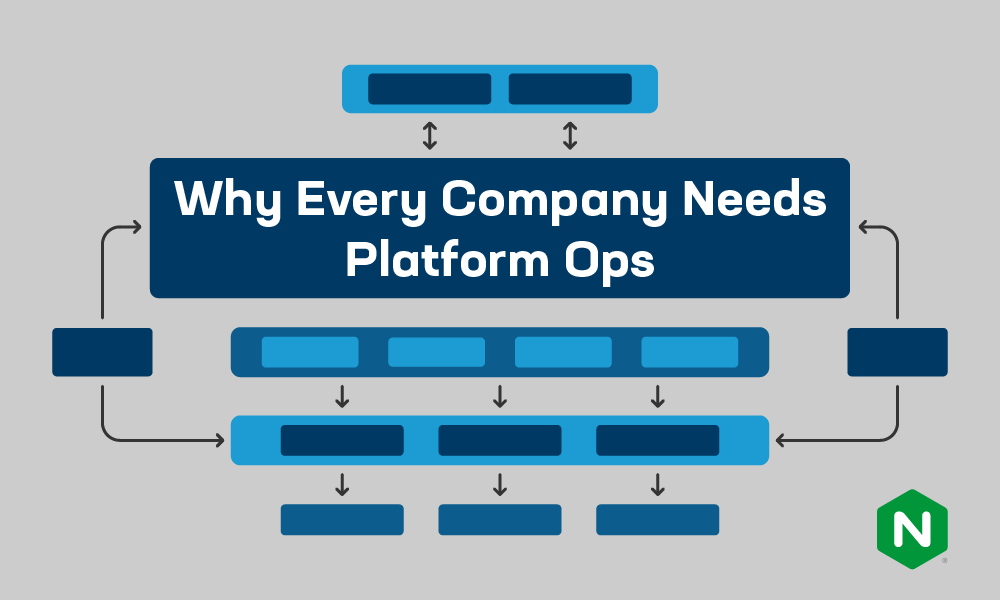The buzz around “Platform Ops” seems to be getting ever louder. You might ask, “Why do we need yet another form of ‘Ops’? We have DevOps, NetOps, SecOps, DevSecOps, and even FinOps!” But in fact Platform Ops is actually different from the other “Ops” and increasingly serves as the glue that holds together all the different organizations and use cases required to meet the needs of technology organizations building modern, distributed, and cloud‑native applications. In other words, we think Platform Ops is rather important.
What Is Platform Ops?
A platform is a collection of technologies used by different engineering teams to perform various functions that all rely on computing power. A web applications team relies on web servers, middleware (like Node.js®), a front end, and load balancers. A team running marketing technology relies on SaaS products like Adobe Creative Cloud and Salesforce. A networking operations team relies on Kubernetes, application delivery controllers, and virtual networking solutions (Kubernetes does a lot of this, too). In the era of cloud computing and cloud‑native applications, all teams rely on a platform that provides not only core computing, storage, and networking capabilities, but also tools for building and delivering applications.
Platform Ops is the team responsible for curating, maintaining, connecting, and securing the platform that provides DevOps teams with what they need to do their jobs. Increasingly, as more and more technology moves to the cloud, Platform Ops is also closely involved in the provision of core functionalities like organization‑wide networking and organization‑wide security.

Why Do You Need Platform Ops?
The world of applications has radically changed in the past decade. Monolithic applications are being refactored into services connected by APIs. Distributed applications may include not only multiple services but also span multiple clouds. Developers have become the masters of their technology stacks, with full power to choose tools as they see fit. In some organizations, CTOs and VPs of IT are finding that across dozens of DevOps teams the company is using hundreds or thousands of different tools and solutions for computing, data, message queues, observability, security, and networking. This is particularly true at the application layer (Layer 7). For example, one of the largest mobile application companies has told us they run multiple Kubernetes clusters and different types of service meshes because its applications teams have used so many different tools and solutions that are incompatible or cannot be supported in a single platform.
A Natural Reaction to Too Much Choice
Platform Ops is a promising solution to this hyper‑proliferation of technology tools burdening enterprises today. A Platform Ops team collaborates with all consumers of IT and applications in the organization, asks them what they want and need, and whittles down the requests to a smaller set of choices. At its core, Platform Ops is an effort to strike a healthy balance between choice and chaos; it seeks to enable enterprises to shift‑left while maintaining strong security, governance, and reliability.
To be sure, some companies still offer applications or DevOps teams the ability to pick their own tools that are not necessarily supported by Platform Ops. Netflix is known for allowing “unpaved road” selections outside of its curated portfolio of technology tools. The condition is that teams electing to travel on unpaved roads are expected to support their own tools without assistance from Platform Ops, IT, or other DevOps teams.
It’s important to note that Platform Ops is not the same as IT consolidation. Whereas IT consolidation tends to be top‑heavy and top‑down, Platform Ops is consultative and bottom‑up. Platform Ops teams must be evangelists and teachers to ensure that all users of the platform understand why choices were made and how to get the most out of what’s available on the platform.
Platform Ops teams usually come from the ranks of application development and DevOps, so they understand the needs and wants of those teams better than anyone. Platform Ops teams also usually still write code – either for internal tooling or for configuration and management – and so end up using the very platform they curate. That’s very different from the usual practice of IT teams, which is to dictate solutions but not use them for their own work.
For companies struggling to navigate the new and confusing environment of cloud, cloud‑native applications, distributed infrastructure, and shift‑left application development and security, the Platform Ops team provides a crucial source of intelligence and assessment. This helps not only the CTO, but also the CFO and procurement and auditing teams, understand what is needed and what the cost might be. In that regard, Platform Ops is the neutral broker that becomes a crucial conduit for information sharing and institutional knowledge.
Conclusion: Platform Ops Will Increasingly Determine Success or Failure for IT Strategies
The reality is that there is always tension between choice and control. But today, enterprises must make themselves attractive places for developers to work and create. Overly limiting developers frustrates them and encourages them to look elsewhere for employment. At the same time, affording too much choice results in a distributed technology environment like a Tower of Babel – a mishmash of incompatible and inconsistently configured and structured tools. Over time, this environment becomes not only unmanageable but also insecure. How well Platform Ops teams can balance these concerns determines whether the organization can successfully navigate digital transformation and build for a cloud‑native, widely distributed future that strikes the right blend of shifted left and buttoned down.
For more about Platform Ops, see the companion article on the New Stack, Platform Ops: The Next Frontier for Operations Teams.

